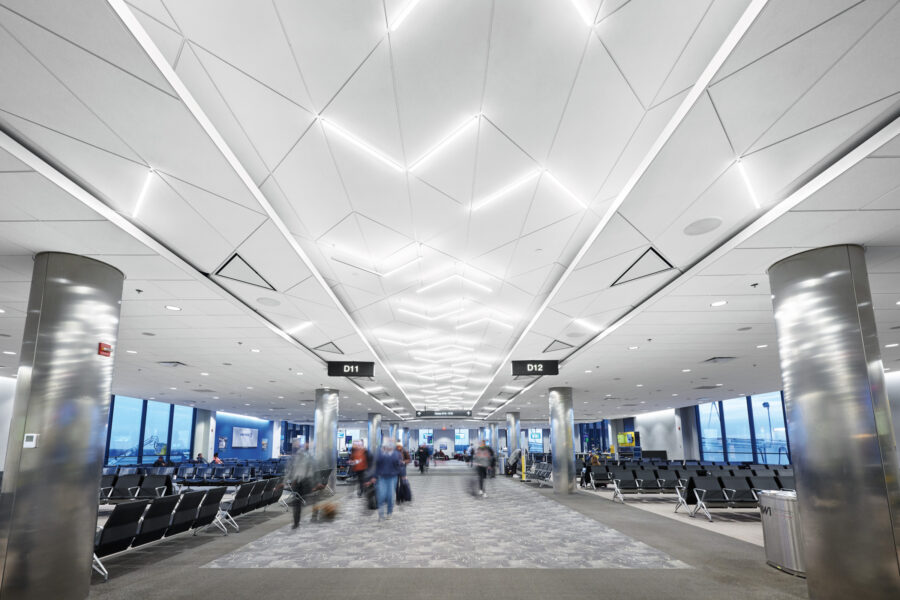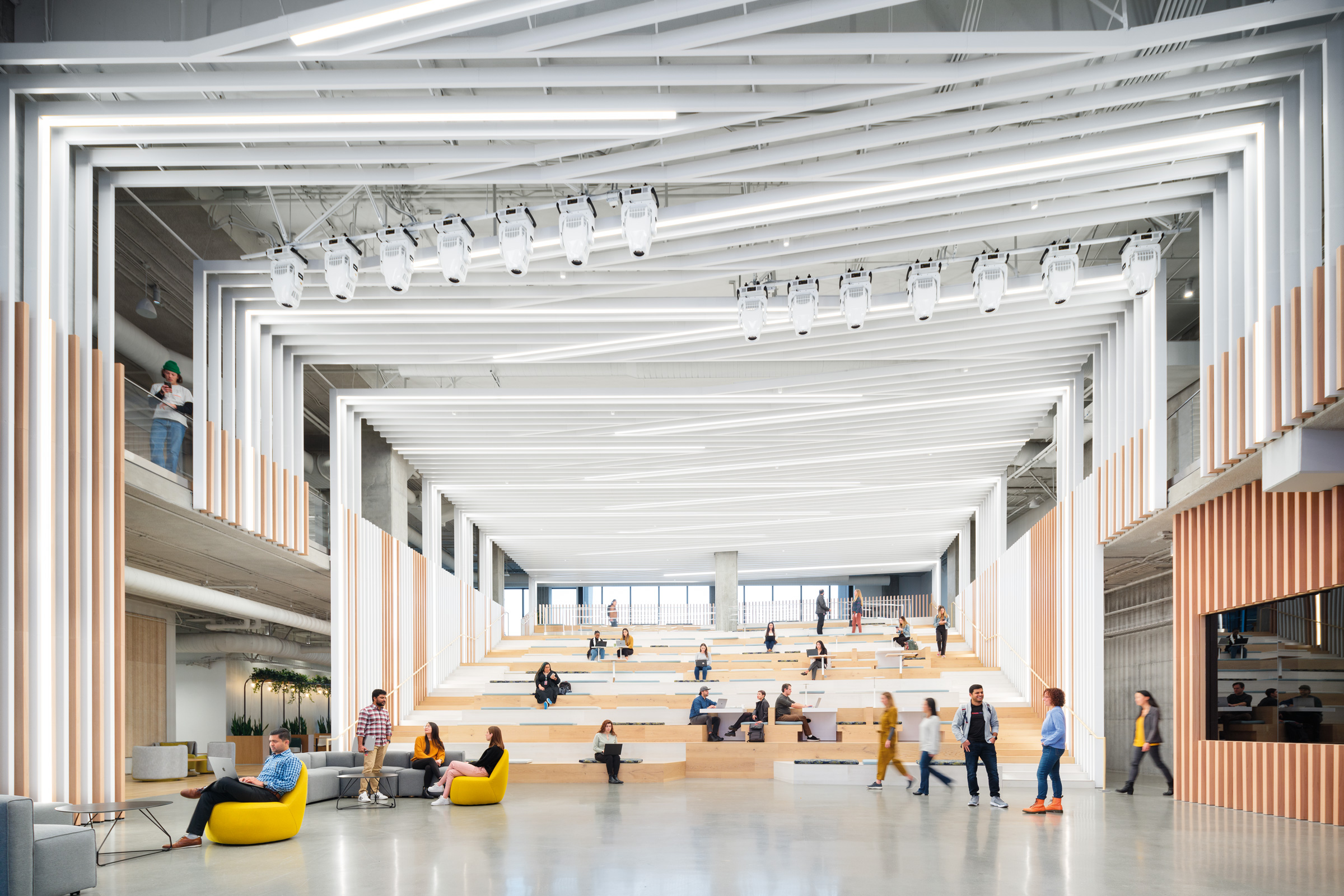Story at a glance:
- Modern ceilings are appreciated as crucial aesthetic elements, incorporating diverse materials and complex designs to enhance the overall visual appeal of spaces.
- Armstrong’s PROJECTWORKS and use of BIM/Revit and 3D software streamline the design, planning, installation, and customization of ceiling and wall solutions—significantly reducing time, materials, and complexity.
- Advanced digital modeling and precise material selection help minimize waste, promoting sustainability and cost-efficiency in ceiling projects.
Ceiling designs of old served primarily functional and utilitarian purposes. Often plain in visual appearance and constructed from highly standardized materials and components, they were little more than an afterthought in design. But those days are no more.
More and more designers and architects are turning to ceilings as an integral aesthetic element in the overall design of a built environment. Moreover, large open floor plans in transportation and other spaces require complex acoustic and lighting solutions that diverge from those typically employed in the past.
Planning and installing modern ceiling solutions can be difficult to begin with, but given the additional challenges of cost efficiency, sustainability, and the demand for quick turnarounds, many projects are complex to say the least, says Nathan Baxter, director of design and digital services at Armstrong World Industries.
“This is a big growth area for us. If you think about acoustical ceilings, most of the standard options in our portfolio are simple, premade ceiling systems. They are two-by-two or two-by-four square or rectangular panels, and they’re not very heavy,” Baxter says.
“When you move into architectural specialty considerations, you immediately start seeing new material types: Things like wood, metal, and potentially translucent products. We also see changes in form factors, and new needs such as hiding the suspension system. Many considerations need to be made around how to manage the weight of those panels, how the material will be used, what size the panels being used will be, and how that ceiling will be applied within the built environment.”
BWI Thurgood Marshall Airport

Photo courtesy of Armstrong World Industries
Armstrong has seen particular growth for custom and specialty ceilings in the transportation space, where aging infrastructure often requires large renovations. Considering these facilities must remain operational throughout the duration of any redesign projects, planning and installation can be extremely challenging.
BWI Thurgood Marshall Airport in Baltimore recently collaborated with Armstrong for an upgrade to its HVAC system, which required a decades-old ceiling be removed and replaced. To meet its objectives the design team was able to install CALLA Shapes for DESIGNFLEX, an Armstrong ceiling solution that allows designers to mix and match shapes, sizes, colors, and materials to create a memorable ceiling more easily. Not only did the contracting crews have no prior experience installing DESIGNFLEX ceilings—they also had to manage installation in the evenings when fewer passengers were in the terminal, making for logistical challenges.
This is where PROJECTWORKS, a complimentary design and pre-construction service offered by Armstrong, comes in. Baxter says PROJECTWORKS allows Armstrong to use proprietary digital technologies to rapidly model the configuration and layout process of various products and solutions. Through PROJECTWORKS Armstrong can deliver information pertaining to utilization as well as installation to customers.
“Utilizing technology to automate this work makes this much faster for customers than the traditional method of drawing it through a standard platform, sharing it with customers, redrawing it, checking to see if it will work, and so forth,” Baxter says. “Things that traditionally took weeks if not months can now be achieved in days or even hours.”
Improving Efficiency with BIM
Building Information Modeling (BIM) is a technology that provides a digital representation of the physical and functional characteristics of a building. It can be used to create and manage data during the design, construction, and operation phases of a building’s life cycle.
A BIM-generated model gives customers access to a fully three-dimensional simulation of a building design and how its various components interact with one another in real-time, Baxter says. In addition, product data is stored within BIM-generated models.
“The ceiling panels, suspension system, lighting components, and more all have manufacturer information attached to them, which is stored in the model. Having that available helps architects and designers create the right specification,” Baxter says. “We can take a model from an architect and provide that model with the solutions they would like to add, and then just drop that back into the master model seamlessly. That allows us to create a collaborative vision piece that streamlines the process and reduces back-and-forth.”
Sustainability Benefits
In addition to streamlining the design and installation process, collaborating with PROJECTWORKS can also improve the sustainability of ceiling projects. By allowing designers and architects to more accurately determine the right materials for their projects in advance, overbuilding can be eliminated.
PROJECTWORKS can facilitate greater material flexibility, too. “A lot of architects and designers will say, ‘Hey, I want to do something new and interesting. I want to push the boundaries,’ but when they do that, they’re often creating unnecessary waste streams. They might want to use a material like wood that requires twice as much as another material might,” Baxter says. “What we do is show customers how they can utilize our standard and premium products that are configurable and can be more easily laid out while still achieving the type of visual they would like within their environment.”


